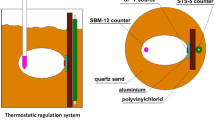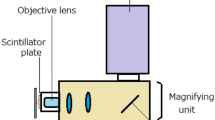Abstract
THIS communication gives the results of an experiment designed to compare methods of absolute alpha counting at Harwell and at the Radiation Laboratory of the University of California at Berkeley. The low-geometry methane proportional chamber, used by us, has been described by Hurst and Hall1. The alpha-particles are collimated by three disks, to prevent reflexion from the chamber walls, and a final collimating disk to define the geometry. The alpha-particles then enter the counting chamber where the collecting electrode, a 0.001-in. diameter tungsten wire at earth potential, is held taut by a small brass ball. A concentric brass cylinder forms the cathode. The methane pressure is maintained at about 8 cm. (of mercury) and a flat plateau of ∼ 600 volts is obtained for the dependence of count-rate on the high tension of the electrode. The critical dimensions, the diameter of the collimating disk and the distance of this from the source (∼ 5 in.), can be measured very accurately. The geometry factor of the chamber for a point source is calculated from the difference between the solid angles subtended at the source by the collimating disk and the ball. There is a small correction for the area of the source: 0.14 per cent for a circular source of radius 0.2 in. The calculated geometry factors of our two chambers are: Counter 12 712.5 ± 0.7 Counter 13 717.3 ± 0.8 the quoted error being due to the possible errors in the dimensions used in the calculation. The chambers have been used in conjunction with the following standard British electronic equipment: power pack type 1007, amplifier type 1049A, potentiometer unit type 1007, scalar type 1009A, timing unit 1003B and a special head amplifier which is a modification of a type 1049A (to operate on negative high tension).
This is a preview of subscription content, access via your institution
Access options
Subscribe to this journal
Receive 51 print issues and online access
$199.00 per year
only $3.90 per issue
Buy this article
- Purchase on Springer Link
- Instant access to full article PDF
Prices may be subject to local taxes which are calculated during checkout
Similar content being viewed by others
References
Hurst, R., and Hall, G. R., Analyst, 77, 790 (1952).
Author information
Authors and Affiliations
Rights and permissions
About this article
Cite this article
GLOVER, K., HALL, G. Precision Alpha-Particle Counting. Nature 173, 991–992 (1954). https://doi.org/10.1038/173991a0
Issue Date:
DOI: https://doi.org/10.1038/173991a0
This article is cited by
-
Der Faktor der inneren Umwandlung beim 40 keV-�bergang des 81 208 T1
Zeitschrift f�r Physik (1958)
-
The determination of radioactive decay constants
Il Nuovo Cimento (1957)
-
Half-life of Curium-242
Nature (1954)
Comments
By submitting a comment you agree to abide by our Terms and Community Guidelines. If you find something abusive or that does not comply with our terms or guidelines please flag it as inappropriate.



